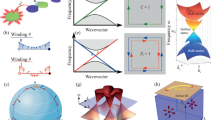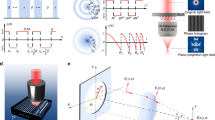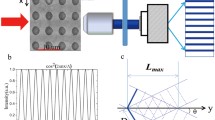Abstract
Novel optical properties in graded photonic super-crystals can be further explored if new types of graded photonic super-crystals are fabricated. In this paper, we report holographic fabrication of graded photonic super-crystal with eight graded lattice clusters surrounding the central non-gradient lattices through pixel-by-pixel phase engineering in a spatial light modulator. The prospect of applications of octagon graded photonic super-crystal in topological photonics is discussed through photonic band gap engineering and coupled ring resonators.
Similar content being viewed by others
References
Chanda D, Abolghasemi L E, Haque M, Ng M L, Herman P R. Multi-level diffractive optics for single laser exposure fabrication of telecom-band diamond-like 3-dimensional photonic crystals. Optics Express, 2008, 16(20): 15402–15414
Ohlinger K, Zhang H, Lin Y, Xu D, Chen K P. A tunable three layer phase mask for single laser exposure 3D photonic crystal generations: bandgap simulation and holographic fabrication. Optical Materials Express, 2011, 1(5): 1034–1039
Leach J, Wulff K, Sinclair G, Jordan P, Courtial J, Thomson L, Gibson G, Karunwi K, Cooper J, Laczik Z J, Padgett M. Interactive approach to optical tweezers control. Applied Optics, 2006, 45(5): 897–903
Xavier J, Dasgupta R, Ahlawat S, Joseph J, Gupta P K. Three dimensional optical twisters-driven helically-stacked multi-layered microrotors. Applied Physics Letters, 2012, 100(12): 121101
Zito G, Piccirillo B, Santamato E, Marino A, Tkachenko V, Abbate G. Two-dimensional photonic quasicrystals by single beam computer-generated holography. Optics Express, 2008, 16(8): 5164–5170
Jenness N J, Wulff K D, Johannes M S, Padgett M J, Cole D G, Clark R L. Three-dimensional parallel holographic micropatterning using a spatial light modulator. Optics Express, 2008, 16(20): 15942–15948
Arrizón V, de-la-Llave D S, Méndez G, Ruiz U. Efficient generation of periodic and quasi-periodic non-diffractive optical fields with phase holograms. Optics Express, 2011, 19(11): 10553–10562
Xavier J, Rose P, Terhalle B, Joseph J, Denz C. Three-dimensional optically induced reconfigurable photorefractive nonlinear photonic lattices. Optics Letters, 2009, 34(17): 2625-2627
Xavier J, Joseph J. Tunable complex photonic chiral lattices by reconfigurable optical phase engineering. Optics Letters, 2011, 36(3): 403–405
Xavier J, Vyas S, Senthilkumaran P, Denz C, Joseph J. Sculptured 3D twister superlattices embedded with tunable vortex spirals. Optics Letters, 2011, 36(17): 3512–3514
Behera S, Joseph J. Single-step optical realization of bio-inspired dual-periodic motheye and gradient-index-array photonic structures. Optics Letters, 2016, 41(15): 3579–3582
Lutkenhaus J, George D, Moazzezi M, Philipose U, Lin Y. Digitally tunable holographic lithography using a spatial light modulator as a programmable phase mask. Optics Express, 2013, 21(22): 26227–26235
Kumar M, Joseph J. Optical generation of a spatially variant twodimensional lattice structure by using a phase only spatial light modulator. Applied Physics Letters, 2014, 105(5): 051102
Rumpf R C, Pazos J. Synthesis of spatially variant lattices. Optics Express, 2012, 20(14): 15263–15274
Digaum J L, Pazos J J, Chiles J, D’Archangel J, Padilla G, Tatulian A, Rumpf R C, Fathpour S, Boreman G D, Kuebler S M. Tight control of light beams in photonic crystals with spatially-variant lattice orientation. Optics Express, 2014, 22(21): 25788–25804
Lutkenhaus J, George D, Lowell D, Arigong B, Zhang H, Lin Y. Registering functional defects into periodic holographic structures. Applied Optics, 2015, 54(23): 7007–7012
Lutkenhaus J, Lowell D, George D, Zhang H, Lin Y. Holographic fabrication of designed functional defect lines in photonic crystal lattice using a spatial light modulator. Micromachines, 2016, 7(4): 59
Lowell D, Lutkenhaus J, George D, Philipose U, Chen B, Lin Y. Simultaneous direct holographic fabrication of photonic cavity and graded photonic lattice with dual periodicity, dual basis, and dual symmetry. Optics Express, 2017, 25(13): 14444–14452
Lowell D, Hassan S, Sale O, Adewole M, Hurley N, Philipose U, Chen B, Lin Y. Holographic fabrication of graded photonic superquasi- crystals with multiple-level gradients. Applied Optics, 2018, 57(22): 6598–6604
Lowell D, Hassan S, Adewole M, Philipose U, Chen B, Lin Y. Holographic fabrication of graded photonic super-crystals using an integrated spatial light modulator and reflective optical element laser projection system. Applied Optics, 2017, 56(36): 9888
Hassan S, Sale O, Lowell D, Hurley N, Lin Y. Holographic fabrication and optical property of graded photonic super-crystals with a rectangular unit super-cell. Photonics, 2018, 5(4): 34
Ge X, Minkov M, Fan S, Li X, Zhou W. Low index contrast heterostructure photonic crystal cavities with high quality factors and vertical radiation coupling. Applied Physics Letters, 2018, 112(14): 141105
Hassan S, Lowell D, Lin Y. High light extraction efficiency into glass substrate in organic light-emitting diodes by patterning the cathode in graded superlattice with dual periodicity and dual basis. Journal of Applied Physics, 2017, 121(23): 233104
Hassan S, Alnasser K, Lowell D, Lin Y. Effects of photonic band structure and unit super-cell size in graded photonic super-crystal on broadband light absorption in silicon. Photonics, 2019, 6(2): 50
Lu L, Joannopoulos J D, Soljačić M. Topological photonics. Nature Photonics, 2014, 8(11): 821–829
Bandres M A, Wittek S, Harari G, Parto M, Ren J, Segev M, Christodoulides D N, Khajavikhan M. Topological insulator laser: experiments. Science, 2018, 359: 4005
Ao Y, Hu X, Li C, You Y, Gong Q. Topological properties of coupled resonator array based on accurate band structure. Physical Review Materials, 2018, 2(10): 105201
Funding
Funding Information National Science Foundation (NSF) (Nos. 1661842 and 1661749).
Author information
Authors and Affiliations
Corresponding author
Additional information
Safaa Hassan received his B.S. and M.S. degrees in Physics from Mustansiriyah University, Baghdad, Iraq, in 2002 and 2005 respectively. In 2005 - 2008, he worked as a researcher in the College of Science/Department of Physics and College of Engineering, Mustansiriyah University, Baghdad, Iraq. In 2008 - 2013, he was hired as a Lecturer in the Department of Physics/College of Science, Mustansiriyah University. He is a Ph. D. candidate at University of North Texas. His current research interests include holographic fabrication of photonic crystals and graded photonic super-crystals, light extraction in organic light emitting diode (OLED) and gradient index photonic devices.
Usha Philipose received her B.S, M.S. and M.Phil. degrees in Physics from University of Bombay, India. She received her Ph.D. degree in Materials Science and Engineering from University of Toronto, Canada, in 2006. She later worked as a postdoctoral researcher at the Centre for Advanced Nanotechnology, University of Toronto, Canada. She joined the Department of Physics at the University of North Texas, Denton in 2008 as an Assistant Professor. She received tenure and was promoted to the rank of an Associate Professor in 2014. Her current research interests include studying electron, photon and phonon transport in 1D nanostructures, as well as increasing the complexity of these structures to study effect on certain functionalities such as its optoelectronic and energy conversion capabilities.
Hualiang Zhang is an Associate Professor at the Electrical and Computer Engineering Department, University of Massachusetts Lowell. He received his B.S. degree in Electrical Engineering from the University of Science and Technology of China in 2003. He received his Ph.D. degree in Electrical and Computer Engineering from the Hong Kong University of Science and Technology in 2007. From 2007 to 2009, he was a postdoctoral research associate in the Department of Electrical and Computer Engineering at the University of Arizona. From 2009 to Jan. 2016, he was a faculty member at the University of North Texas. His research interests include metamaterials, nano-photonics, optoelectronics, RF/microwave/millimeter-wave circuits and systems, antennas, and their applications. He is the co-author of over 200 journal and conference papers. Dr. Zhang is a senior member of IEEE.
Yuankun Lin received his B.S. and M.S. degrees in Physics from Nankai University, Tianjin, China, in 1991 and 1994, respectively. He received his Ph.D. degree in Physics from the University of British Columbia, Vancouver, Canada, in 2000. In 2000 - 2004, he worked as a postdoctoral research fellow in photonics group in the Department of Electrical and Computer Engineering, University of Toronto. Then he was hired as an Assistant Professor in 2004 and promoted to an Associate Professor in 2007 at University of Texas Pan American. In 2010, he was hired as an Associate Professor in the Department of Physics and Department of Electrical Engineering at the University of North Texas and promoted to Full Professor in 2015. His current research interests include holographic fabrication of photonic crystals and graded photonic super-crystals, light extraction in OLED, gradient index photonic devices and phase mask.
Rights and permissions
About this article
Cite this article
Sale, O., Hassan, S., Hurley, N. et al. Holographic fabrication of octagon graded photonic supercrystal and potential applications in topological photonics. Front. Optoelectron. 13, 12–17 (2020). https://doi.org/10.1007/s12200-019-0941-2
Received:
Accepted:
Published:
Issue Date:
DOI: https://doi.org/10.1007/s12200-019-0941-2




